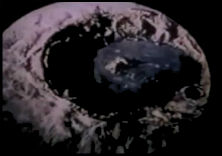
1950 Film About a Moon Landing
What prompted the Navy's interest in a science fiction film centered on a Moon landing?
In 1950 the film "Destination Moon" premiered, showcasing a vision of a moon landing. The filmmakers were entirely confident that such a journey would soon become a reality, often expressing their certainty in interviews. A significant contributor to the film's visual elements was artist Chesley Bonestell, who worked alongside Wernher Von Braun and Hermann Oberth, both of whom played crucial roles in the Apollo moon landings two decades later. The image below shows the Tycho crater on the moon compared to a 1950 crater shown in the film "Destination Moon". If it was possible to fabricate such images in 1950 (remember that we had not yet been into space) one might question why a similar feat could not be achieved in 1969.

And why was the US Navy interested in the making of a science fiction film in the late forties?
During the film's production a separate camera crew captured behind-the-scenes footage, conducting interviews with the director and other key personnel. At one point a Navy Lieutenant is introduced as "another Naval guest," suggesting the presence of additional Navy representatives during the filming. The Lieutenant expresses curiosity about whether the filmmakers might be perceived as "mad scientists," but he is quick to express his admiration for their work, stating on camera that what he witnessed was far from "mad scientists" and expressed his admiration that these kind of pictures were being produced. This rare 47-minute documentary provides a comprehensive overview of the Apollo narrative, including details such as the decompression of the lunar module and the necessity for astronauts to leave behind equipment like life support packs and cameras on the moon. The Navy's interest in a 1950 science fiction film raises intriguing questions about the intersection of military and cinematic endeavors during that era. The parallels between the 1950 film "Destination Moon" and the Apollo moon landing, which occurred two decades later, are striking. This raises again an intriguing question: Did they also fabricate the Apollo Moon Landing in 1969?
Episode of "City at Night," TV magazine show, hosted by Keith Hetherington and Dorothy Gardiner. The program presents a "live" behind-the-scenes look at the shooting of the film "Destination Moon" and was broadcasted in 1949. The clip below shows the interview with the Navy Officer.
"Navy Officer: We are doing a lot of rocket work out at white sands, as you know, so this is of interest to us. When we first heard about it we were afraid that mayby it was one of those mad scientist, wicked woman routines, but we see that it isn't like that at all and it is heartening to see this kind of picture being made. When the scientific facts are adhered too and educate the public along this lines, I think it is a very encouraging thing.
Host Show: I am glad it has the full approval of the Navy because it looks to me like a scientific picture not just a bit of fiction.
Navy Officer: Well we are impressed with the uhh tremendous amount of research they have done on this and they have come to us for help on the uhh a few problems and so we hope we have been of service to them.
Host Show: Well i bet you will have been an invaluable service."
Willy Ley and Werhner von Braun
An intriguing aspect of "Destination Moon" is that Willy Ley was initially appointed as the film's technical adviser but was dismissed after he argued that explosions in space would not produce sound due to the vacuum. The surprising replacement for Ley was none other than Wernher von Braun, who later became embroiled in controversy surrounding the Apollo moon landing.
In those days Willy Ley was the science editor of Galaxy Magazine, a popular magazine in the 1950's. The son of H. Gold, the editor of Galaxy magazine recalls the circumstances surrounding Ley's dismissal as an advisor for the film Destination Moon, which led to Wernher von Braun taking his place. It became evident that von Braun prioritized the film's propaganda elements over scientific accuracy. This unexpected lay off of Willy ley as science advisor for the film Destination Moon is documented in the video below.
E.J. Gold recalls why Willy Ley was fired and Wernher von Braun was hired (Video 0:40)
"Willy (ley) was hired for a movie called "Destination Moon", May 1950 about the first manned space flight to the moon, which science fiction authors had seen coming for years. It was one of the very first major budget science fiction films and it was made in 1950, it was one of the very first. and so uhhh Willy was asked uuhh to be the technical advisor on the film. One of the first thing he said is, you know you can't have sound, explosions in space because the sounds in space don't happen, there is nothing to transmit this, you have to have a atmosphere in order to transmit sound waves, sound waves don't transmit in space because space is a vacuum. So he was fired summarily and Wernher Von Braun was asked the same question: what can we do to make these explosions? He said of course you can have sound in space go ahead, have all the sound you want in space. So he was hired . That is the story, expediency rules."




